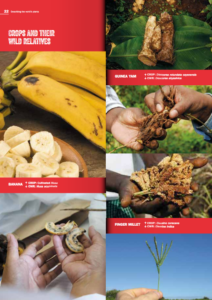Åsmund Bjørnstad, a plant breeder and professor at the Norwegian University of Life Sciences at Ås, recently published a stimulating article on plant patents. We asked Daniele Manzella, a policy and legal consultant, to comment. Below are his thoughts. Interested readers may also want to read another recent post on seed IP issues. It is, of course, all very timely.
Åsmund Bjørnstad has recently published a piece in Trends in Biotechnology, under the title “Do Not Privatize the Giant’s Shoulders’: Rethinking Patents in Plant Breeding.” ((Bjørnstad Å (2016). ‘Do Not Privatize the Giant’s Shoulders’: Rethinking Patents in Plant Breeding. Trends in biotechnology PMID: 27016032)) The author starts with a diagnosis that could be seen as controversial: IPRs have an increasing impact on plant breeding. They do not necessarily promote it, though. Arguably, they also delay it.
With plant varieties subject to both plant breeders rights and, with some variations, patents, and with patents spreading into the non-GM breeding sector (e.g. induced mutants, native traits) — just to depict some features of the intricate layering of proprietary claims — the risk of dependency threatens the breeding sector and cannot be mitigated by good breeding practices only. Companies invest considerable resources to monitor protected elements.
Add to that the contentious regulatory area of access to germplasm, composed of requirements stemming from the CBD, the International Treaty and now the Nagoya Protocol, with its corollary of MTAs and market- and non-market-based benefit-sharing schemes, and the blockage to innovation becomes even more robust. The consequences are legal uncertainty and rising costs linked to complex “freedom to operate” analyses, non-optimal technology integration, a narrowing genetic base for breeding due to access restrictions and the resultant avoidance by users.
Åsmund wants to clear the blockage of this anti-commons scenario by combining variety registration and compulsory licensing. Under the label of ‘toll roads, not road blocks’, he introduces the idea of breeders having to declare “patents used” (i.e. patented varieties, traits, or technologies, methods utilized etc.) when registering a new variety for commercialization, to then obtain compulsory licenses from title holders. He extends the proposal to include a declaration of the origin of germplasm, from a country of origin or from the Multilateral System of the Treaty.
In his view, this transparent solution rewards inventors, supports innovation and maintains fairness. A win-win-win!
The proposal is a generous attempt to constructively advance the debate on how to incentivize modern breeding for food security in the current legal landscape. It deserves attention on its merits by scholars and practitioners, who will certainly examine his piece in depth and with the necessary rigor. Åsmund rightly calls for more legal analysis, recognizing some tension with the TRIPS provisions on compulsory licensing. For instance, how to reconcile his proposal with the requirement that compulsory licenses be used predominantly for local markets?
However, I want to pose a more general question in this post, with the hope of triggering discussion. Åsmund’s proposal relies on legislative reforms, presumably of both patent and seed legislation. My question is: are legislative solutions feasible? And, will industry support them? My perception is that industry is in search of solutions that are both timely and global. Among its several strengths, Åsmund’s proposal may show some weakness on both those counts.
Global legal harmonization is slow and rarely keeps pace with technology evolution (in our sector, predictive breeding may soon be a reality). To what extent is it feasible that countries will reach a level of agreement and commitment that translates into harmonized legislative reforms in the various jurisdictions? Is it foreseeable that countries worldwide will act in sync on such heavily debated and complex topics, where multiple interests are intertwined (for instance, I am not addressing in this post developing country perspectives on plant innovation).
Without such agreement and commitment, global scale will not be reached and we will continue adding pieces to the current puzzle of national patent — and seed — laws. Indeed, patent laws are harmonized through minimum standards but, beyond those minimum standards, already display considerable differences from one jurisdiction to another, in terms of rights, limitations and exceptions. Not to mention case law, which is another source of differentiation.
In a nutshell, the current industry initiative for vegetable crops (which you will find described in Åsmund’s article) may well be no more than exploratory, limited in scope and merely voluntary. However, it is cooperative, autonomous and fast — three features that are desirable in any attempt to stimulate a more favourable policy and legal environment for plant breeding.
 To coincide with the
To coincide with the